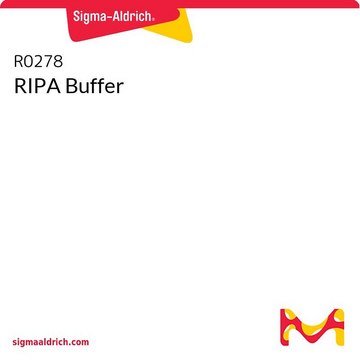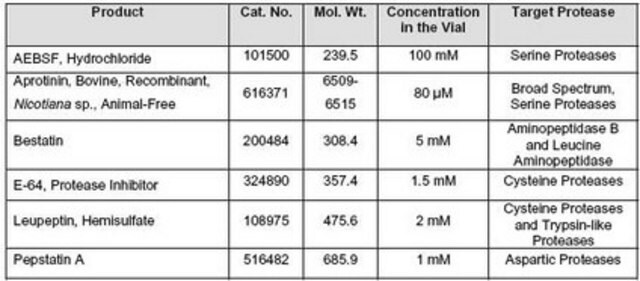I3911
Protease Inhibitor Cocktail
Animal-Free, lyophilized powder, for the inhibition of serine, cysteine, aspartic and metalloproteases, for general use, lyophilized powder
Synonym(s):
protease inhibitor
Sign Into View Organizational & Contract Pricing
All Photos(1)
About This Item
UNSPSC Code:
12352200
NACRES:
NA.77
form:
lyophilized powder
solubility:
water: soluble
storage temp.:
−20°C
Recommended Products
Product Name
Protease Inhibitor Cocktail, Animal Component Free, for general use, lyophilized powder
Quality Level
form
lyophilized powder
solubility
water: soluble
storage temp.
−20°C
Looking for similar products? Visit Product Comparison Guide
Related Categories
General description
Components of this cocktail are of non-animal origin and no animal products were used in the component production process. All vessels and instruments used for the cocktail production are dedicated for animal component free production and have never encountered an animal product. Aprotinin used in this cocktail is a recombinant bovine protein expressed in plants (Nicotiana).
This protease inhibitor cocktail has been optimized and tested for mammalian cell and tissue extracts. It contains inhibitors with a broad specificity for serine, cysteine, and acid-proteases, and aminopeptidases.
Specificity
Inhibits serine, cysteine, aspartic, and metalloproteases.
Application
Animal component free (ACF). Optimized and tested for general use. Protease Inhibitor Cocktail, Animal Component Free has been used to prevent protein lysis in saliva samples, peritoneal residential macrophage cells and in embryo culture medium.
Components
AEBSF
Aprotinin
Bestatin
E-64
EDTA
Leupeptin
Aprotinin
Bestatin
E-64
EDTA
Leupeptin
Quantity
One bottle makes 100 mL of cocktail, which are sufficient to the inhibition of proteases present in approximately 20 gram of cell extract.
Not all extracts contain the same levels of endogenous enzymes, and it may be necessary to adjust the volume of cocktail required.
Not all extracts contain the same levels of endogenous enzymes, and it may be necessary to adjust the volume of cocktail required.
Physical form
Lyophilized powder that is water soluble.
The components of this ACF cocktail do not originate from animal sources and can thus be used in the production of animal free proteins.
Signal Word
Danger
Hazard Statements
Precautionary Statements
Hazard Classifications
Eye Dam. 1 - Skin Corr. 1A
Storage Class Code
8A - Combustible corrosive hazardous materials
WGK
WGK 3
Flash Point(F)
Not applicable
Flash Point(C)
Not applicable
Choose from one of the most recent versions:
Already Own This Product?
Find documentation for the products that you have recently purchased in the Document Library.
Customers Also Viewed
Preliminary analysis of the protein profile in saliva during physiological term and preterm delivery
Lopucki M, et al.
Molecular Medicine Reports, 17(6), 8253-8259 (2018)
Functional evaluation of multiple human transgenes to overcome immunological and coagulation barriers associated with pig-to-human xenotransplantation.
Bongoni, A.K. et al.
Thesis, 108-108 (2013)
Marija Holcar et al.
Scientific reports, 10(1), 21346-21346 (2020-12-09)
Human plasma is a complex fluid, increasingly used for extracellular vesicle (EV) biomarker studies. Our aim was to find a simple EV-enrichment method for reliable quantification of EVs in plasma to be used as biomarker of disease. Plasma of ten
Early protein profile of human embryonic secretome.
Foresta C, et al.
Frontiers in Bioscience, 21, 620-634 (2016)
Carlo Foresta et al.
Frontiers in bioscience (Landmark edition), 21, 620-634 (2015-12-29)
Embryos obtained by in vitro fertilization are currently assessed by morphology, but displays limitations with over 70% of embryos failing to implant. In this study, we performed HPLC-MS/MS analysis on the conditioned medium obtained from 50 human embryos at the
Our team of scientists has experience in all areas of research including Life Science, Material Science, Chemical Synthesis, Chromatography, Analytical and many others.
Contact Technical Service














